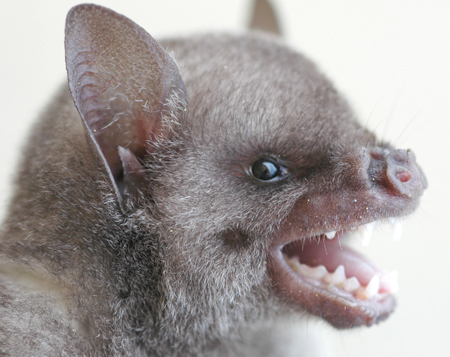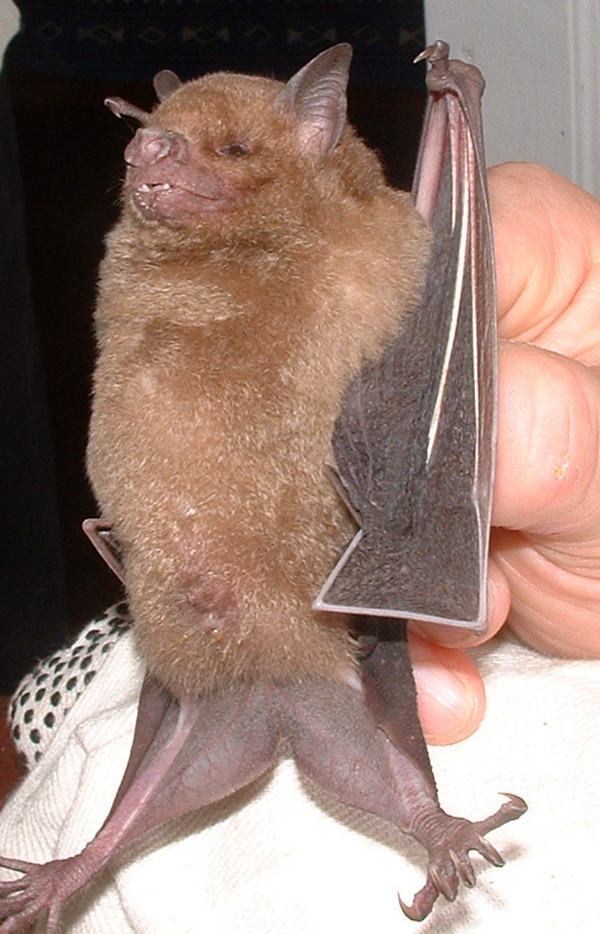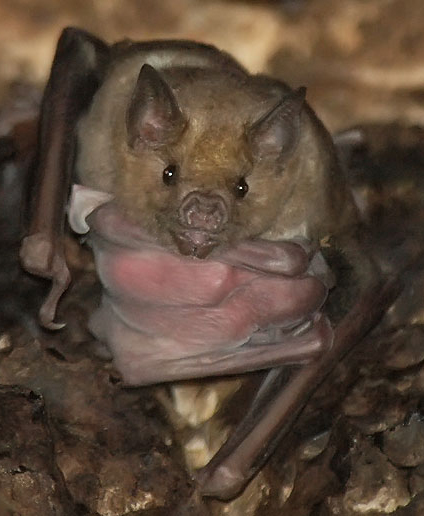Guide to the bats of Montserrat
Artibeus jamaicensis Chiroderma improvisum Brachyphylla cavernarum Noctilio leporinus Ardops nichollsi Sturnira thomasi Monophyllus plethodon Molossus molossus Tadarida brasiliensis Natalus stramineus Key to Roosts Key to Taxa
Brachyphylla cavernarum
(Photo A. Hartpence)
K. Questel (photo)
Lesser Antillean Fruit Bat - Brachyphylla cavernarum
STATUS: These bats are known from Puerto Rico and the Virgin Islands in the Greater Antilles and most of the islands in the Lesser Antilles. Pig-nosed bats have been mist-netted in a wide range of habitats from rain forest to dry scrub woodland and gardens, and seem able to tolerate a degree of environmental disturbance.IDENTIFICATION: Brachyphylla are large, muscular bats with a wingspan of about 45cm. They have a fairly short snout ending in a stumpy noseleaf in the form of a circular pad of flesh around the nostrils, this making the face look slightly pig-like.The eyes are relatively small compared with other kinds of leaf-nosed bat. The fur is long, thick, and ranges from tan-white to brown. The wings are fairly broad and the tail membrane is a relatively thin along thin inner surfaces of the back legs.
ROOSTS: This species is most often found roosting in caves, both deep inside dark, humid caves and sometimes in well-lit shallow rock overhangs. They also make use of man-made cave-equivalents - deep tarrish pits and large wells. Large colonies exist on most islands in the region, often moving among 2-3 separate roosting locations. Unlike many other species, these bats have an aggressive attitude towards members of their own species, thereby making their roosts very active and very noisy throughout the day. These bats often wait until well after sunset before leaving their roosts. Their populations are quite vulnerable to roost disturbance due to the colony-forming nature of this species.DIET: Pig-nosed bats eat pollen, nectar, fruit, and insects. A range of wild and cultivated fruits are eaten; the pulp is chewed until dry then spat out (in captivity, insects are dealt with in the same way). Like the Jamaican fruit bat, several hundred Pig-nosed bats will mob fruit trees en masse, but have been seen to chase away Jamaican Fruit bats that try to feed close to them. They prefer to feed around the tops of trees, but will move lower down as the food runs out. They can be noisy feeders, "squabbling" with other bats at trees where they are feeding and dropping blossoms or fruits onto the ground as they eat. Their droppings vary in size and their appearance depends on what they have been eating: they may be dark brown-black, fluid and sticky after a fruit meal, or coarse and crumbly with glistening specks of insect exoskeleton after eating insects. Larger pieces of exoskeleton (like beetle wing covers) may also be found with droppings. Because these bats feed on fruit and flowers, they will have some impact on cultivated fruit production; they are the only species on the islands known to eat pigeon peas. However, they are useful and important seed dispersers and pollinators of many wild tree species. Pig-nosed bats may be more tolerant of habitat disturbance than other fruit bats, primarily because their omnivorous palate may allow them to survive the lean times immediately following natural disasters (hurricanes) when the standing fruit crop is destroyed by high winds.
REPRODUCTION: Breeding may be synchronized, with births occurring around June and matings probably four months before that. Nursing mothers have been found June until August, being most common in July. Pregnant females have been found in April. During a good year, a second baby may be born later in the year. Young bats start flying at about two months old.
SIZE: Forearm length - 65mm [range 59-70mm]; Mass - 49g [range 34-55g]; Wingspan - approx. 440 mm; Head+body length - 80-95mm
COMMENTS: Other names: Brown Flower bat.
REFERENCE: Mammalian Species No. 205: Brachyphylla cavernarum. by Pierre Swanepoel & Hugh H. Genoways. 6pp (American Society of Mammalogists, 1993)
See Entry: Walker's Mammals of the World Online version 5.1, by Ronald Nowak, 1997



